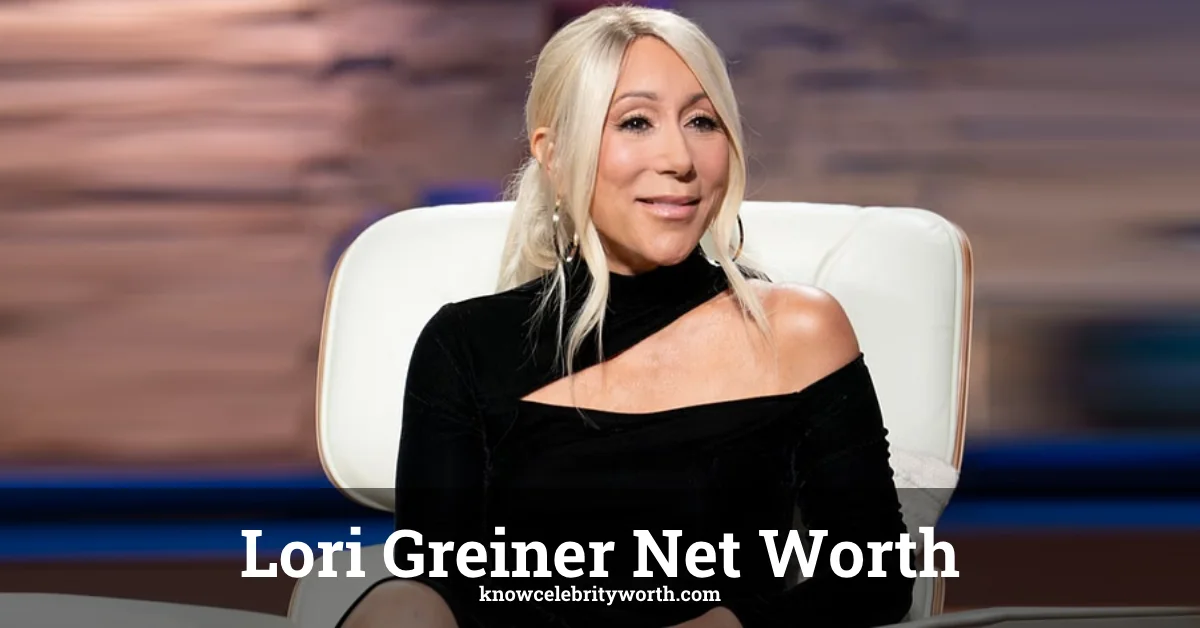Lori Greiner is worth $150 million in 2025. She turned a single jewelry organizer into a business with over 1,000 products and 120 patents.
Many know her from Shark Tank, where she backs everyday inventors. Before that, she built her brand on QVC, turning small ideas into million-dollar products.
How Lori Greiner Built Her $150M Net Worth?
Greiner’s $150 million net worth comes from several income streams:
- Product sales are her biggest money-maker. Her 1,000+ products sell through QVC, retail, and online. Industry estimates put her revenue between $50 and $100 million a year.
- Shark Tank deals add to her wealth. She’s backed over 100 companies, including Scrub Daddy, now worth more than $200 million. While she typically takes 10-30% equity stakes, these investments have multiplied her initial capital many times over.
- Television appearances pad her bank account nicely, too. Reports suggest she earns around $50,000 per Shark Tank episode. With 14 seasons under her belt, that’s serious money. Add her regular QVC appearances and guest spots on other shows, and TV likely brings in $1-2 million annually.
- Her book and speaking gigs add smaller, steady income streams. Corporate events pay top dollar for her entrepreneurial wisdom—often $50,000 to $100,000 per appearance.
Early Life and First Big Bet
Born in Chicago on December 9, 1969, Greiner grew up in a middle-class family. Her father worked as a real estate developer while her mother focused on raising the family. Money wasn’t abundant, but creativity was.
Young Lori Greiner showed entrepreneurial sparks early. She’d organize neighborhood events, sell handmade crafts, and constantly brainstorm new ideas. Her parents encouraged this creative streak, even when her schemes got messy.
After high school, Greiner headed to Loyola University Chicago. She studied communications, journalism, and film skills that would later prove invaluable for selling products on television. College life exposed her to diverse perspectives and sharpened her ability to connect with different audiences.
After college, she briefly worked at the Chicago Tribune but felt boxed in. At 27, she made a bold move that changed her life.
Breakthrough with QVC
Greiner’s journey to QVC stardom began with frustration. She couldn’t find a decent way to organize her jewelry. Tangled necklaces and missing earrings drove her crazy. So she sketched out a solution—a plastic organizer with separate compartments for each piece.
With $300,000 borrowed against her future (and a lot of faith from her husband Dan), she manufactured the first batch. Local stores showed interest, but sales moved slowly. Then J.C. Penney placed an order. That validation pushed her to think bigger.

QVC invited her on air in 1998. Her first appearance was nerve-racking—she had to connect with viewers while selling her product under bright studio lights.
Her product sold out in minutes. QVC noticed not just the sales but how well she connected with viewers. She spoke their language, understood their problems, and offered real solutions.
Within two years, her products were generating $1 million in sales. By year five, that number hit $10 million. QVC made her a regular, eventually dubbing her the “Queen of QVC.” Her segments became appointment television for loyal customers who trusted her taste.
The QVC platform taught Greiner invaluable lessons. She learned to spot products that solve real problems. She mastered the art of demonstrating value in seconds. Most importantly, she built relationships with millions of customers who became her loyal fan base.
Biggest Shark Tank Wins
When Shark Tank producers approached Greiner in 2012, she hesitated. The show meant more time away from her Chicago home and QVC commitments. But the opportunity to help inventors on a national stage won her over.
Her Shark Tank persona emerged naturally—the encouraging mentor who saw potential where others saw problems. While other sharks focused on tech or fashion, Greiner gravitated toward everyday solutions. Kitchen gadgets, organizers, and household helpers became her sweet spot.
Scrub Daddy is her biggest Shark Tank win. While others passed, she invested $200,000 for 20%. It’s now made over $670 million in sales, making it the most successful Shark Tank product ever.
Other notable investments showcase her range. Squatty Potty transformed bathroom habits (and conversations) across America. Simply Fit Board became a fitness phenomenon. Drop Stop solved the annoying problem of items falling between car seats. Each investment reflected her knack for spotting products people didn’t know they needed.
Her investment strategy differs from other sharks. She offers more than money—she provides QVC access, retail connections, and hands-on mentoring. Entrepreneurs often choose her lower offers over higher bids from other sharks because they value her expertise.
Behind the scenes, Greiner works closely with her companies. She refines packaging, suggests product improvements, and leverages her retail relationships. This hands-on approach explains why her portfolio companies often outperform expectations.
Income Sources
Breaking down Greiner’s income reveals a carefully constructed financial ecosystem. Each revenue stream supports and amplifies the others, creating compound growth.
Product sales remain her foundation. Her company, For Your Ease Only, Inc., holds over 120 patents and produces hundreds of products. Kitchen organizers, travel accessories, and beauty tools dominate her catalog. Conservative estimates put annual product revenue between $50-100 million, with profit margins around 15-20%.
Shark Tank investments provide both immediate returns and long-term wealth building. While she’s selective (investing in only about 20% of the deals she makes on air), her success rate is impressive. Industry watchers estimate her Shark Tank portfolio is worth $50-75 million, generating millions in annual dividends and distributions.
Shark Tank pays her about $50,000 per episode, over $1 million per season, totaling over $1 million per season. QVC appearances, while harder to quantify, likely match or exceed that amount. Guest appearances on other shows add another few hundred thousand annually.
Speaking engagements command premium rates. Corporate events, entrepreneurship conferences, and women’s business groups pay $50,000-100,000 for her insights. With 10-20 major speaking gigs per year, this adds $1-2 million to her annual income.
Her book “Invent It, Sell It, Bank It!” became a bestseller, generating royalties and boosting her speaking fees. While book sales alone might only produce six figures annually, the credibility boost impacts all her other ventures.
Licensing deals expand her reach without requiring capital investment. Companies pay to use her name, image, and expertise on their products. These passive income streams likely generate several million annually.
Wealth Growth Timeline
Tracking Greiner’s financial journey reveals steady, strategic growth rather than overnight success.
- 1996-1997: Started with $300,000 in borrowed money. First-year sales reached $500,000—barely breaking even after expenses.
- 1998-2000: QVC debut changed everything. Sales jumped to $1 million in year two, then $5 million by 2000. Net worth crossed $1 million.
- 2001-2005: Rapid expansion phase. Annual sales hit $10 million. Launched dozens of new products. Net worth reached $5-10 million.
- 2006-2010: Established QVC dominance. Sales plateaued around $20-30 million annually. Diversified into new product categories. Net worth grew to $20-30 million.
- 2011-2012: Joined Shark Tank. Initial investments were modest but strategic. Book deal signed. Net worth approached $50 million.
- 2013-2015: Scrub Daddy exploded. Other investments gained traction. Speaking fees soared. Net worth doubled to $100 million.
- 2016-2020: Portfolio companies matured. New investments balanced failures. The pandemic boosted home product sales. Net worth reached $120-130 million.
- 2021-2025: Continued steady growth across all income streams. Strategic exits from mature investments. Current net worth stands at $150 million.
Private Life Behind the Scenes
Despite her public success, Greiner keeps her personal life remarkably private. She’s been married to Dan Greiner since 2010, though they’d been together much longer. Dan plays a crucial but quiet role in her empire, serving as CFO and chief sounding board.
The couple chose not to have children—a decision Greiner addresses honestly when asked. She pours her nurturing instincts into mentoring entrepreneurs and building businesses. Her “babies” are the products and companies she helps grow.
Home base remains Chicago, where she and Dan live in a Lincoln Park mansion. But work keeps her traveling constantly between Chicago, Los Angeles for Shark Tank filming, and Philadelphia for QVC appearances. She’s mastered the art of productive plane time, often reviewing proposals at 30,000 feet.
She often works 16-hour days, managing product launches, investments, and TV appearances, juggling product development, investment analysis, and media appearances. But she’s quick to credit her team, especially Dan, for making it all possible.
Philanthropy plays an increasing role in her life. She supports entrepreneurs through mentorship programs and startup competitions. Women’s business organizations benefit from her time and treasure. She’s particularly passionate about helping inventors from underserved communities access resources.
How Lori Greiner Spends—and Invests—Her Money?
Greiner’s wealth manifests in strategic assets rather than flashy displays. Her primary residence in Chicago’s Lincoln Park neighborhood is valued at around $2-3 million—nice but not ostentatious for someone of her wealth.
She maintains a second home in the Philadelphia area for QVC’s convenience. This practical purchase saves hotel costs and provides a quiet workspace near the QVC studios. Combined real estate holdings likely total $5-10 million.
Her car collection reflects utility over luxury. While she could afford any vehicle, she’s often spotted in practical SUVs that hold product samples and presentation materials. She jokes that her car is a mobile office.
The real luxury in Greiner’s life is freedom—freedom to choose projects, freedom to help inventors, freedom to say no. She flies first class for comfort during long workdays, stays in nice hotels for security and convenience, and employs a solid team to handle details.
Her biggest splurge might be her jewelry collection—ironic given her start with jewelry organizers. But even here, she favors pieces with stories over pure extravagance. Many come from inventors she’s helped or commemorate business milestones.
Greiner reinvests most profits back into new ventures. She maintains substantial liquid reserves for investment opportunities and operates with the mindset of an entrepreneur, not a retiree. Every dollar has a job, whether funding new products, supporting portfolio companies, or seeking the next big opportunity.
Her lifestyle philosophy mirrors her business approach: smart, practical, and focused on value. She lives well but not wastefully, enjoys success but stays hungry, and measures wealth in impact as much as dollars.
Conclusion
Looking ahead, Greiner shows no signs of slowing down. At 55, she has the energy of someone half her age and the wisdom of someone twice her age. Her net worth will likely continue climbing as portfolio companies mature and new investments bear fruit.
But for Lori Greiner, the scorecard isn’t just about money. It’s about products that make life easier, inventors who achieve their dreams, and problems that get solved. That’s how she defines success: solving problems, helping inventors, and building products that matter.
